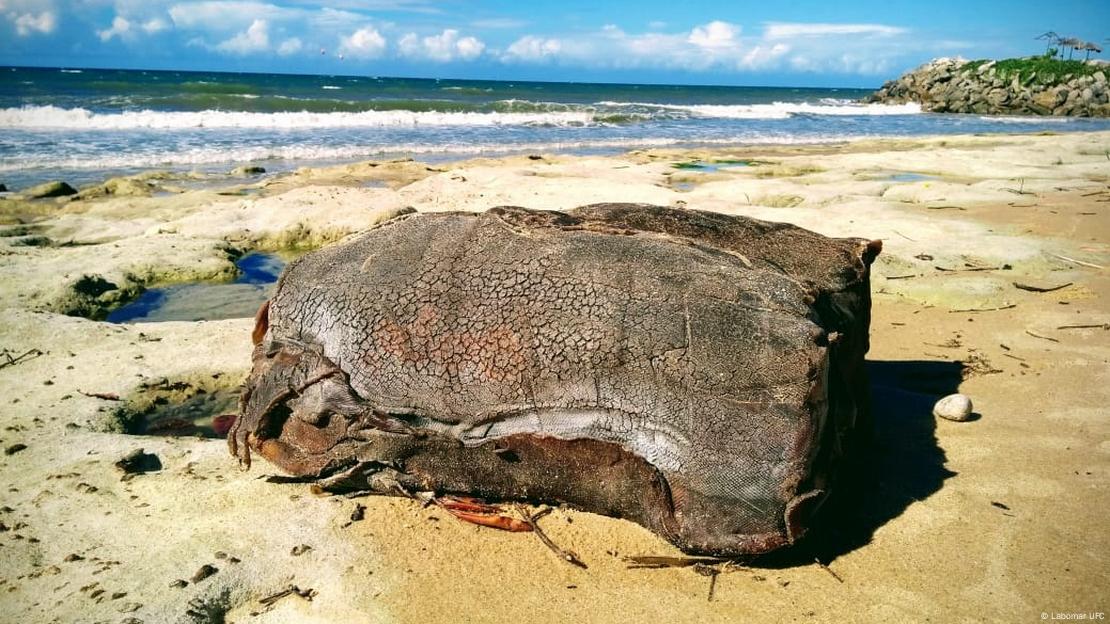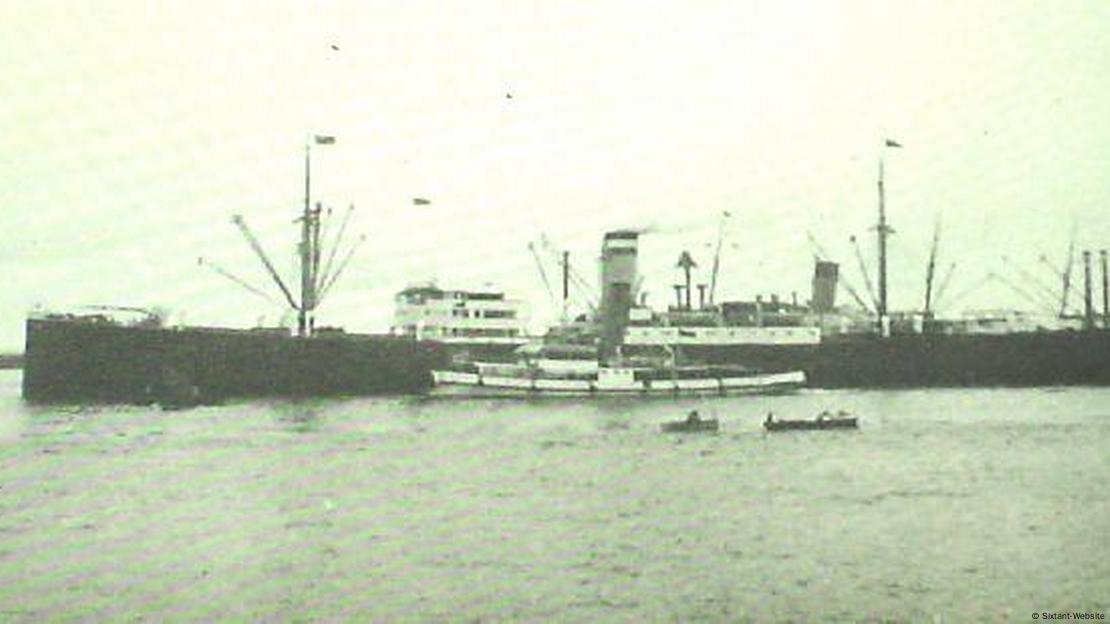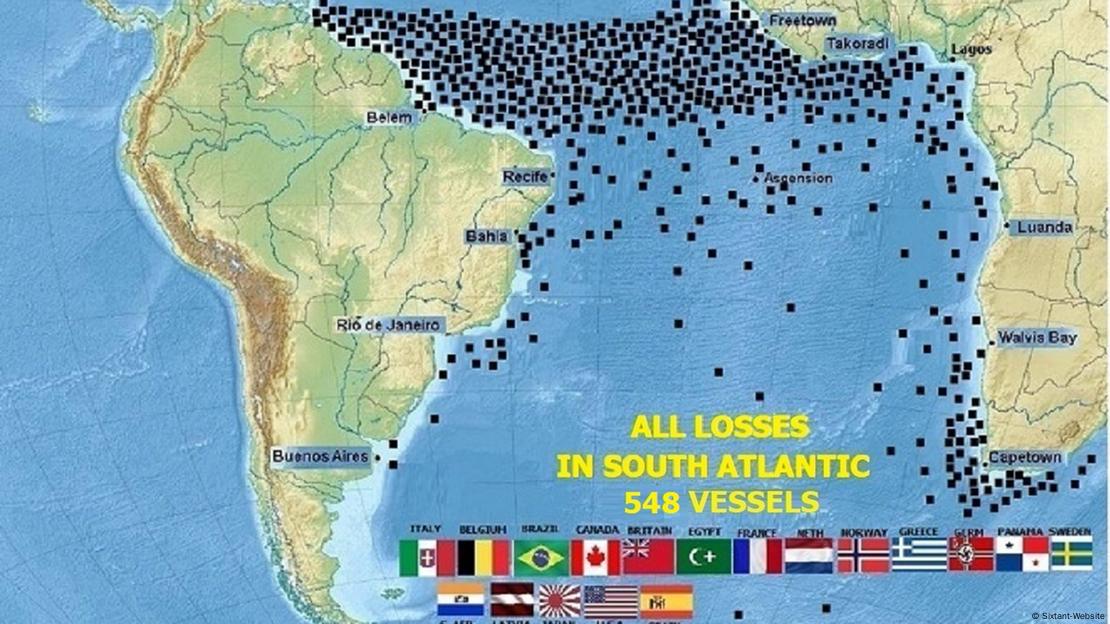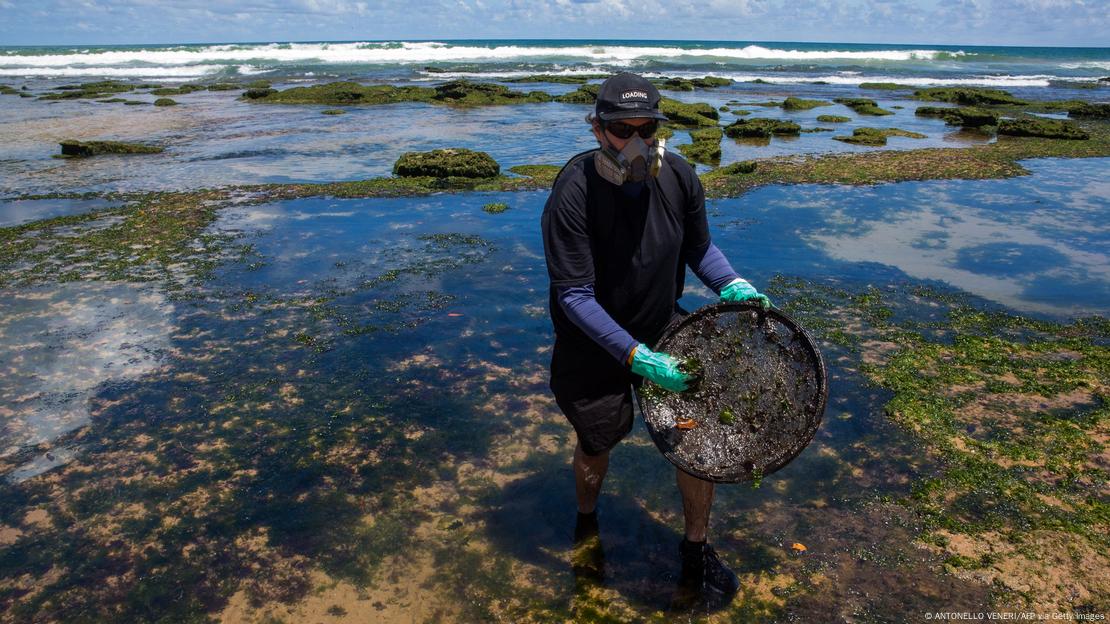ECOCIDE
DW
There are more than 500 WWII wrecks off the coast of Brazil, some containing valuable metals. Researchers warn that the hunt for these resources could cause massive oil spills.
The Esso Hamburg was scuttled in 1941 while carrying a large cargo of oilImage: www.aukevisser.nl via Sixtant-Website
Brazilian marine biologists have solved a mystery that has long perplexed researchers across the world: Where do the heavy chunks of rubber that have often been washed up on beaches in northeastern Brazil over the past several years come from?
According to research by the Institute of Marine Sciences (Labomar) at the Federal University of Ceara (UFC) and the Autonomous University of Barcelona, the rubber bales, weighing up to 200 kg (441 lb), come from the German cargo ship MS Weserland, among others. It sank on January 3, 1944, and lies at a depth of more than 5,000 meters (16,404 feet) in the South Atlantic.

Brazilian marine biologists have solved a mystery that has long perplexed researchers across the world: Where do the heavy chunks of rubber that have often been washed up on beaches in northeastern Brazil over the past several years come from?
According to research by the Institute of Marine Sciences (Labomar) at the Federal University of Ceara (UFC) and the Autonomous University of Barcelona, the rubber bales, weighing up to 200 kg (441 lb), come from the German cargo ship MS Weserland, among others. It sank on January 3, 1944, and lies at a depth of more than 5,000 meters (16,404 feet) in the South Atlantic.

Clumps of rubber like this have long been washing up on Brazilian beaches
Image: Labomar UFC
Resource for the war
During the First and Second World Wars, rubber was an important material for the manufacture of cars, planes and uniforms. During the Second World War, Germans traveled to Southeast Asia, including Singapore, Malaysia and what was then Indochina — now Vietnam, Laos and Cambodia — to procure bales of latex.
They also loaded cargoes of metals such as cobalt, zinc and the mixed mineral wolframite. Brazilian marine researchers have calculated that the cargo carried by the MS Weserland could be worth $17-68 million (€15-61 million), taking the zinc price of May 2021 as a basis.
"This ship had loaded wolframite, a substance that experienced a boom on the stock markets during the pandemic especially, because it is used to manufacture mobile telephones, tablets and computers," says Luis Ernesto Arruda Bezerra from the Institute of Marine Sciences at the UFC.

The wreck of the MS Weserland is believed to be the source of the rubber balesImage: Sixtant-Website
'Ticking timebombs'
A study that is soon to be published by the scientific journal Ocean and Coastal Research (OCR) and that DW has already seen proves that the loss of the rubber bales from the wreck has coincided with the rising price for the metal cargo. The journal is published by the Oceanographic Institute at the University of Sao Paulo.
According to the foreword of the study, this supports the hypothesis that unauthorized deep-sea salvage operations are taking place in international waters.
It is estimated that there are 3 million sunken and abandoned ships cross the world's oceans. Among them are 8,500 "potentially polluting wrecks," according to statistics from the International Union for Conservation of Nature (IUCN).
Mass Allied submarine sinkings
Researchers at the Federal Universities of Alagoas (Ufal) and Ceara (UFC) have used mathematical simulations and the analysis of currents between Brazil and Africa to determine that the rubber was in two former German Nazi ships that were sunk during the Second World War in the South Atlantic.
The website Sixtant records information about ships that have been sunk in the South Atlantic. The UFC researchers used this information while looking for the provenance on the rubber bales. The website shows 25 German submarines and an Italian submarine that were sunk during the Second World War in a joint action by the US, Brazilian and British navies.
The website has listed altogether 548 ships that were sunk in the South Atlantic between 1939 and 1945. Fifty-six of them were German.

Sixtant has records of hundreds of shipwrecksImage: Sixtant-Website
There were also ships that transported more than 7,000 tons of heating oil and 1,200 tons of diesel oil, like the Esso Hamburg, which was scuttled in June 1941. According to the Sixtant website, at least four ships were transporting heating oil, and five rubber.
The first rubber bales, which were washed up in 2018 and 2019 in Brazil, came from the MS Rio Grande. This German ship was sunk by the US in 1944 as it tried to break through the sea blockade imposed by the US.
Lack of monitoring in international waters
The UFC researchers believe that the clumps of rubber are released from the ships for two reasons: because of the natural deterioration of the shipwrecks, and because pirates and illegal operations are hunting for raw materials.
They say that the monitoring of shipwrecks in international waters off the Brazilian coast is not enough to indentify potential polluters. This monitoring has been carried out up to now by the US.
The UFC intends to try to map the shipwrecks in an effort to classify the risks they pose to the Brazilian coast.
"But that is not a simple endeavor, as most of these ships are lying at a depth of more than 4,000 meters," says Marcelo Soares from the UFC's Institute of Marine Sciences.
There were also ships that transported more than 7,000 tons of heating oil and 1,200 tons of diesel oil, like the Esso Hamburg, which was scuttled in June 1941. According to the Sixtant website, at least four ships were transporting heating oil, and five rubber.
The first rubber bales, which were washed up in 2018 and 2019 in Brazil, came from the MS Rio Grande. This German ship was sunk by the US in 1944 as it tried to break through the sea blockade imposed by the US.
Lack of monitoring in international waters
The UFC researchers believe that the clumps of rubber are released from the ships for two reasons: because of the natural deterioration of the shipwrecks, and because pirates and illegal operations are hunting for raw materials.
They say that the monitoring of shipwrecks in international waters off the Brazilian coast is not enough to indentify potential polluters. This monitoring has been carried out up to now by the US.
The UFC intends to try to map the shipwrecks in an effort to classify the risks they pose to the Brazilian coast.
"But that is not a simple endeavor, as most of these ships are lying at a depth of more than 4,000 meters," says Marcelo Soares from the UFC's Institute of Marine Sciences.

The 2019 oil spill off Brazil is still not fully explainedImage: ANTONELLO VENERI/AFP via Getty Images
Environmental disaster as a 'side-effect'
"An operation dismantles a ship to extract the metal, and rubber and oil can be released as a side-effect, which reach the coast because they are driven by the currents. So the question is not whether the oil will spill, but when it will spill," says Arrruda Bezerra.
Between 2020 and July 2024, the Brazilian navy reported a monthly average of 14 oil leakages of various origins off the Brazilian coast, which amounts to 758 such incidents in all. This year so far, 87 cases involving 153,700 liters (40, 603 gallons) of spilled oil have been reported.
Arruda Bezerra fears that the leakage of oil from the wrecks could cause an environmental tragedy like the one in 2019. In that year, Brazil saw the biggest oil spill ever recorded in tropical waters, with around 5,000 tons of oil washed onto shore in altogether 11 states.
The cause remains uncertain.
This article was translated from German.

No comments:
Post a Comment